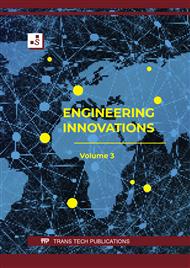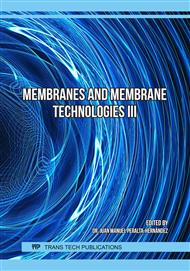[1]
P. Zhang, J. Hu, W. Li, and H. Qi, Research Progress of Brackish Water Desalination by Reverse Osmosis,, J. Water Resour. Prot., vol. 05, no. 03, p.304–309, 2013,.
DOI: 10.4236/jwarp.2013.53031
Google Scholar
[2]
G. Kronenberg, Cogeneration with the LT-MED desalination process,, Desalination, vol. 108, no. 1–3, p.287–294, 1997,.
DOI: 10.1016/s0011-9164(97)00038-6
Google Scholar
[3]
V. I. Diaratih and W. Hadi, Alternatif Pemanfaatan Air Limbah dari Reverse Osmosis dengan Metode Elektrolisis untuk Menghasilkan Gas Hidrogen dan Oksigen,, J. Tek. Its, vol. 4, no. 1, p.4–6, (2015).
Google Scholar
[4]
N. Ahmad and R. E. Baddour, A review of sources, effects, disposal methods, and regulations of brine into marine environments,, Ocean Coast. Manag., vol. 87, p.1–7, 2014,.
DOI: 10.1016/j.ocecoaman.2013.10.020
Google Scholar
[5]
N. Afrasiabi and E. Shahbazali, Ro brine treatment and disposal methods,, Desalin. Water Treat., vol. 35, no. 1–3, p.39–53, 2011,.
DOI: 10.5004/dwt.2011.3128
Google Scholar
[6]
M. S. Islam, A. Sultana, A. H. M. Saadat, M. S. Islam, M. Shammi, and M. K. Uddin, Desalination Technologies for Developing Countries: A Review,, J. Sci. Res., vol. 10, no. 1, p.77–97, 2018,.
DOI: 10.3329/jsr.v10i1.33179
Google Scholar
[7]
L. Mariah et al., Membrane distillation of concentrated brines-Role of water activities in the evaluation of driving force,, J. Memb. Sci., vol. 280, no. 1–2, p.937–947, 2006,.
DOI: 10.1016/j.memsci.2006.03.014
Google Scholar
[8]
K. Jevons and M. Awe, Economic benefits of membrane technology vs. evaporator,, Desalination, vol. 250, no. 3, p.961–963, 2010,.
DOI: 10.1016/j.desal.2009.09.081
Google Scholar
[9]
M. Kurihara, H. Yamamura, and and T. Nakanishi, High Recovery / High pressure Membranes for Brine Conversion SWRO Process Development and its Performance Data,, Eur. Desalin. Soc. Int. Water Serv. Assoc., vol. 125, p.9–15, (1999).
DOI: 10.1016/s0011-9164(99)00119-8
Google Scholar
[10]
K. G. Nayar et al., Feasibility study of an electrodialysis system for in-home water desalination in urban India,, Dev. Eng., vol. 2, p.38–46, 2016,.
Google Scholar
[11]
P. Krivosik, N. Mo, S. Kalarickal, and C. E. Patton, Hamiltonian formalism for two magnon scattering microwave relaxation: Theory and applications,, J. Appl. Phys., vol. 101, no. 8, p.083901, Apr. 2007,.
DOI: 10.1063/1.2717084
Google Scholar
[12]
T. Hoshino, Preliminary studies of lithium recovery technology from seawater by electrodialysis using ionic liquid membrane,, Desalination, vol. 317, p.11–16, 2013,.
DOI: 10.1016/j.desal.2013.02.014
Google Scholar
[13]
P. Del Moral and Valero fernando, - Theory and applications,, Mean F. Simul. Monte Carlo Integr., p.85–124, 2020,.
Google Scholar
[14]
B. Pilat, Practice of water desalination by electrodialysis,, Desalination, vol. 139, no. 1–3, p.385–392, 2001,.
DOI: 10.1016/s0011-9164(01)00338-1
Google Scholar
[15]
N. B. Goodman, R. J. Taylor, Z. Xie, Y. Gozukara, and A. Clements, A feasibility study of municipal wastewater desalination using electrodialysis reversal to provide recycled water for horticultural irrigation,, Desalination, vol. 317, p.77–83, 2013,.
DOI: 10.1016/j.desal.2013.02.010
Google Scholar
[16]
D. A. Vermaas, D. Kunteng, M. Saakes, and K. Nijmeijer, Fouling in reverse electrodialysis under natural conditions,, Water Res., vol. 47, no. 3, p.1289–1298, 2013,.
DOI: 10.1016/j.watres.2012.11.053
Google Scholar
[17]
S. Mikhaylin and L. Bazinet, Fouling on ion-exchange membranes: Classification, characterization and strategies of prevention and control,, Adv. Colloid Interface Sci., vol. 229, p.34–56, 2016,.
DOI: 10.1016/j.cis.2015.12.006
Google Scholar
[18]
C. X. Liu, D. R. Zhang, Y. He, X. S. Zhao, and R. Bai, Modification of membrane surface for anti-biofouling performance: Effect of anti-adhesion and anti-bacteria approaches,, J. Memb. Sci., vol. 346, no. 1, p.121–130, 2010,.
DOI: 10.1016/j.memsci.2009.09.028
Google Scholar
[19]
G. Grossman and A. A. Sonin, Membrane fouling in electrodialysis: a model and experiments,, Desalination, vol. 12, no. 1, p.107–125, 1973,.
DOI: 10.1016/s0011-9164(00)80178-2
Google Scholar
[20]
J. A. Sanmartino, M. Khayet, M. C. García-Payo, H. El-Bakouri, and A. Riaza, Treatment of reverse osmosis brine by direct contact membrane distillation: Chemical pretreatment approach,, Desalination, vol. 420, no. May, p.79–90, 2017,.
DOI: 10.1016/j.desal.2017.06.030
Google Scholar
[21]
C. M. Pereira, C. A. Neiverth, S. Maeda, M. Guiotoku, and L. Franciscon, Complexometric titration with potenciometric indicator to determination of calcium and magnesium in soil extracts1,, Rev. Bras. Ciência do Solo, vol. 35, no. 4, p.1331–1336, 2011,.
DOI: 10.1590/s0100-06832011000400027
Google Scholar
[22]
R. B. Barnes, D. Richardson, J. W. Berry, and R. L. Hood, AND ENGINEERING CHEMISTRY Rapid Analytical Procedure,, no. 11, (1945).
Google Scholar
[23]
S. Casas, C. Aladjem, J. L. Cortina, E. Larrotcha, and L. V. Cremades, Seawater Reverse Osmosis Brines as a New Salt Source for the Chlor-Alkali Industry: Integration of NaCl Concentration by Electrodialysis,, Solvent Extr. Ion Exch., vol. 30, no. 4, p.322–332, 2012,.
DOI: 10.1080/07366299.2012.686849
Google Scholar
[24]
M. Sadrzadeh, A. Razmi, and T. Mohammadi, Separation of different ions from wastewater at various operating conditions using electrodialysis,, Sep. Purif. Technol., vol. 54, no. 2, p.147–156, 2007,.
DOI: 10.1016/j.seppur.2006.08.023
Google Scholar
[25]
D. E. López and J. P. Trembly, Desalination of hypersaline brines with joule-heating and chemical pre-treatment: Conceptual design and economics,, Desalination, vol. 415, no. April, p.49–57, 2017,.
DOI: 10.1016/j.desal.2017.04.003
Google Scholar
[26]
L. Irving, Kosugi 1977 first stille,, vol. 14, no. 2, p.1–2, 2005, [Online]. Available: papers3://publication/uuid/E14B9526-AFAD-49FC-A72C-E3065CE66AD7.
Google Scholar
[27]
C. Pretreatment, For Lenntech,, no. October, (2013).
Google Scholar




